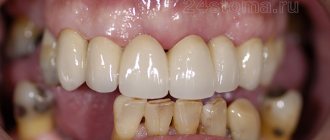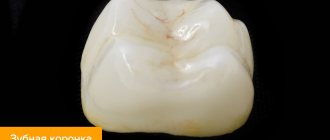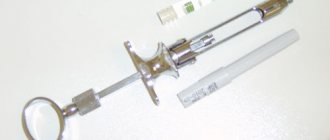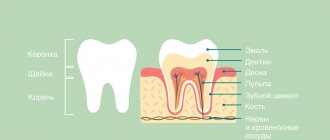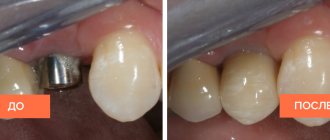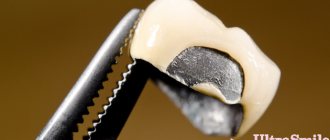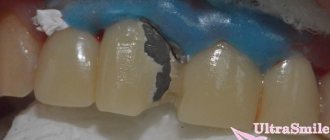- What kind of crowns are placed on teeth?
- Is it painful to grind down a tooth for a crown?
- Read more about teeth grinding
There are several reasons for using crown prosthetics.
Let us remind you that a crown is a tool for single prosthetics, which is used in the following cases: pathological pigmentation of teeth, violation of its anatomical shape, cracks, destruction of the coronal part by more than 60% of the tissue volume. To install a crown, the patient will need to go through the following steps:
- Diagnostics.
- Preparation of the tooth stump.
- Taking impressions.
- Making a crown.
- Fitting and final installation.
What kind of crowns are placed on teeth?
The following prostheses are used for dental prosthetics with crowns:
- Metal-ceramic is a budget-friendly, strong and durable crown option. The base of the prosthesis is metal, the top lining is ceramic. This ensures its strength and external aesthetics.
- All-ceramic - crowns for the front teeth are made from ceramic, since the material is not suitable for the significant chewing loads that are inherent in the lateral and chewing teeth.
- Zirconium dioxide is a premium material in modern orthopedics, used to restore both anterior and chewing teeth, as it has unsurpassed strength and naturalistic aesthetics today.
How is filing of front teeth performed?
The technique of filing teeth varies depending on the condition of the oral cavity, the current diagnosis and treatment goals. Teeth filing begins with a detailed diagnosis. The specialist evaluates the feasibility of the procedure and identifies the teeth that need correction. For an accurate diagnosis, an examination is carried out, the causes of the disease are studied, and a treatment method is determined. The procedure consists of simple steps:
- Determination of the working area. For this, wax plates or special aerosols are used. The use of additional means allows you to mechanically highlight or paint an area that stands out from the general row and prevents the normal closure of teeth. In particularly advanced situations, it will be necessary to create a plaster model of the client’s jaw;
- Anesthesia if a large layer of hard tissue is to be removed;
- Direct filing with a diamond bur. On chewing teeth, the enamel is removed in the areas of protruding cusps. In the case of incisor processing, multidirectional movements are used to create the correct tooth shape;
- Grinding the surface, using products to replenish the deficiency of enamel minerals, as well as drugs to reduce sensitivity and strengthen dental tissue.
After filing, the thickness of the enamel changes, so sensitivity often increases. This phenomenon is temporary and for some time after treatment it is better to refrain from eating too hot or cold food. If the problem does not go away, it is better to consult a dentist.
What is meant?
Metal ceramics – two-layer prosthesis. The bottom layer is metal, the top layer is ceramic lining. In any case, such a product cannot be “thin”. This means that in order for the artificial tooth to be the ideal size, the stump will have to be considerably ground. In most cases, preparation will require depulpation of the nerve. Naturally, all this is done under local anesthesia, and the patient does not feel pain. Let us immediately note that while the dental technicians are making the prosthesis, the doctor will cover the ground tooth with a temporary “cap” in order to avoid hyperesthesia, a reaction to cold or hot.
Zirconium is not only the most durable and beautiful, but also the thinnest prosthesis. To install a zirconium dioxide crown, the tooth can be ground only slightly. In most cases, pulp preparation is not required. Many patients refuse anesthesia because there is no pain during the process of removing the top layer of enamel. If a person has a low pain threshold, then doctors use local or topical anesthesia so that the person feels physically and emotionally comfortable.
The thickness of the ceramic crown is average - between “thick” metal ceramics and “thin” zirconium. This means that the degree of grinding, and as a result, the level of trauma of the procedure, is determined individually in each specific case.
Author:
Mayorov Andrey Mikhailovich
Specialization:
orthopedic dentistry, dental prosthetics, implant installation
When is a doctor needed?
If your teeth ache for longer than 7 days after grinding, you should make an appointment with your doctor. The reason for contacting a specialist may also be:
- inflammation and bleeding of gums,
- the appearance of neoplasms on the mucous membrane,
- bad breath,
- pain when chewing and brushing teeth.
The listed symptoms cannot be ignored. Even with minor discomfort, it is better to consult a doctor to exclude the development of serious diseases.
Complications after filing teeth
If the manipulation is carried out in a dental office under the guidance of a qualified specialist, there is a small chance of a mild complication in the form of a temporary increase in sensitivity. All reviews of teeth filing prove that the side effect goes away quickly and does not cause concern.
To avoid any complications and side effects, you should not try to file your teeth at home. Attempts to use improvised tools to correct the dentition often cause chipping of enamel particles, the appearance of cracks and damage to several teeth at the same time. Successful and high-quality sharpening of teeth is possible only with diagnostics, professional dental instruments and therapeutic agents.
What methods of hard tissue preparation exist?
Despite the development of progressive technologies, today in dental practice doctors carry out the preparation of hard tissues in 99% of all cases using a conventional drill and a diamond tip mounted on it. The procedure is similar to drilling out caries. Less commonly used are laser or ultrasonic methods, as well as air abrasive and chemical methods - all of them are applicable only if it is necessary to remove a minimum amount of tissue, but bur is suitable for any clinical situations.
Sign up for installation of dental inlays at a discount:
What is a tooth core?
Stump inlays are structures that enter one third of the tooth canal, restoring the lost part of the tooth from above. A crown is installed on top of the stump inlay, which is made from the material chosen by the patient.
Often there are teeth restored with “extended” fillings on pins. It should be noted here that some dentists install huge fillings on their patients’ posts instead of crowns. Such fillings do not last very long, and they fall out even if you do not chew anything hard. As a result of chewing, this huge filling, together with the pin, goes sideways and breaks the root of the tooth in which the pin was installed. Such a root usually has to be removed. In rare cases, it is possible to install a crown on a broken tooth. This usually happens in cases where the crack is not below the level of the gum.
How long have dental inlays been used on the Russian dental market?
Quite a long time ago, more than 10 years. It’s just that not all patients agree to visit the doctor several times. They want to do everything in one day, so they choose large fillings, fillings on pins (“extended”). Some doctors make concessions to such patients and do as the patients want, but this is wrong. A healed tooth with a large filling will simply chip quickly, and there is a chance of losing the tooth altogether, so it is better to put an inlay on it.
How many tabs have you installed as a specialist?
Hard to say. I've been working with tabs for about five years. We install 10-15 tabs per month. There are patients who need to install several inlays at once, for example, due to increased tooth wear.
Let's summarize our conversation. What is better - an inlay, a crown or a filling?
Everything is done according to indications, but, of course, a ceramic dental inlay is best.
Let me give you an example: I had patients who had a ceramic inlay installed on one side and a metal-ceramic crown on the other. And according to reviews, the inlay is much better, since most often food gets under metal-ceramic crowns and accumulates under them. This may cause an unpleasant odor.
If metal-ceramic crowns were installed, the metal edge may be exposed, which does not add aesthetics.
Patients also do not like large fillings, which shrink after a certain time, and there is a high probability of chipping the tooth wall or caries.
In these cases, tabs are the best option.
Doctor, thank you for the detailed story!
Expert opinion
Emir Romanovich Omerelli
Maxillofacial surgeon, implantologist
Experience: more than 13 years
By grinding the abutment teeth to secure the bridge, you will inevitably shorten their service life. How quickly they deteriorate and require replacement is an individual matter, but removing a layer of living tissue is not beneficial in any case. If there are no contraindications to implantation, it is better to install artificial roots and attach a bridge to them. At the same time, you do not harm healthy teeth and receive a guarantee of long-term trouble-free operation of the prosthesis.
Adhesive prostheses
This is a relatively new technique for restoring the integrity of the dentition with minimal preparation of supporting units. At the same time, the latter are not depulped, that is, they remain “alive”. And they are not covered with artificial crowns. To install an adhesive prosthesis:
- Shallow grooves are sawed on the teeth adjacent to the defect;
- a prosthesis on a beam is installed in the prepared “niches”;
- From above, the fixation site is covered with composite materials.
Adhesive prosthetics is a progressive and affordable alternative to the installation of metal-ceramic bridge structures. One of its advantages is the ease of replacing such a system if the patient desires to choose a different method of dentition restoration.
Examples of work “Before” and “After”
Express dental implantation ROOTT on the lower jaw
Case: periodontitis, severe root exposure, bone atrophy, as well as a high degree of tooth mobility in the lower jaw.
Express implantation ROOTT and removable prosthetics
Case: partial edentulism of the upper and lower jaws, periodontitis in the lower jaw, severe atrophy of bone tissue, mobility of teeth.
Methods for fixing a crown
In modern dentistry, a crown is placed in 3 ways
.
Installing a crown on a pin
If the tooth root is not destroyed and is healthy, then a pin is placed inside. It is easy to install; before installation, the doctor gives an injection with an anesthetic.
The pin is placed in the tooth socket and secured with special solid compounds.
A crown prosthesis is installed on the pin itself.
It is also possible to restore a tooth without a pin using CEREC technology.
Fixing the prosthesis using a tab
A stump inlay is a cast stump of a tooth with a root part.
When installing a crown, the same method is used as when installing a pin. The dentist makes a hole in the tooth, and the root part of the inlay is placed into it. Next, a crown is put on it, just like, for example, on a living tooth ground before the procedure.
Implant supported crowns
A fixed prosthesis lasts much longer than a removable one; it is more reliable and durable. To install such a prosthesis, you need the strongest possible fixation on the patient’s tooth.
It is not always possible to save the root of a tooth; in order to install a crown on an implant, the tooth is removed.
An implant is installed in place of the removed unit. The implant material can be different, it all depends on the budget. It can be titanium or ceramic (zirconium).
Outwardly it resembles a small bolt that needs to be screwed into place of the removed tooth root.
The third installation option is the longest and most expensive, but the patient actually receives a new tooth that will not be susceptible to caries, destruction and will not hurt.
Preparation before installing a crown
In order for the crown to fit tightly to the tooth, it must be ground. The procedure is quite painful, so the doctor will use an anesthetic.
The degree of turning depends on the thickness of the crown, as well as what material is chosen.
In most cases, the nerve of the tooth is removed because it can be burned during the grinding process.
Removal of the nerve involves cleaning the canals and their sanitation. If the removal of pulp or the cleaning of the canals was of poor quality, then pain may appear under the crown.
A tooth under a crown can hurt for various reasons. We will talk about them further in the sections of the article.
After grinding, an impression is taken from the tooth, and a plaster model is made from it in a special laboratory. The prosthesis is cast along it.
While the prosthesis is being made, the patient is given a temporary onlay for the tooth. After all, during the period of turning it becomes more sensitive. The temporary structure is made of plastic and placed on temporary cement.
When installing a permanent implant, the old structure is removed, the remaining cement is cleaned off and a new crown is secured.
This is called fitting it in, only if the patient does not complain of pain in the tooth under the crown, the gums do not hurt, and nothing interferes, then the structure is placed on an already strong, durable composition.
There is no way to remove it. To remove such a crown, the tooth will have to be sawed into two parts.
When should the crown be removed?
You should not carry out this procedure yourself; it should be done by an experienced dentist.
The crown is removed if there is deformation, chips, or cracks.
When the service life has already expired.
If there is pain under the crown, it gets worse from time to time.
How painful is the procedure?
The procedure is unpleasant psychologically, but the preparation will be carried out only after the doctor gives you anesthesia - the anesthetic is given even when the grinding is minimal or when the tooth is already “dead”, i.e. it lacks a nerve. This will help you feel absolutely no pain or discomfort in the dentist’s chair. True, some patients, after the effect of anesthesia wears off, note the occurrence of pain reactions. In most cases, pain occurs when a sufficiently large layer of tissue is removed, i.e. before prosthetics with crowns or bridges. Then this is a natural phenomenon that is associated with interference in the living tissues of the body. After all, during the preparation, the doctor used a drill, which heated the tissue and pushed back the gum in order to create a ledge.
The unpleasant sensations should pass soon, but if they continue to bother you for more than 3-5 days and increase in intensity, then be sure to see a doctor. Perhaps the specialist made mistakes when grinding hard tissues, which resulted in an inflammatory process.
Structures with interlocking connections
For prosthetics of one or two teeth without turning adjacent units, the CBW prosthetic system can be used. Its features:
- Small canals with a diameter of about 1 mm and a length of 1.5-2 mm are formed on the lateral parts of the supporting teeth.
- Locks made of titanium or zirconium are inserted into these microcavities and secured with glue.
- The intermediate part of the prosthesis is fixed with installed locks.
This method makes it possible to save adjacent teeth, but it is more often used as a temporary option, since CBW systems cannot be called durable.

